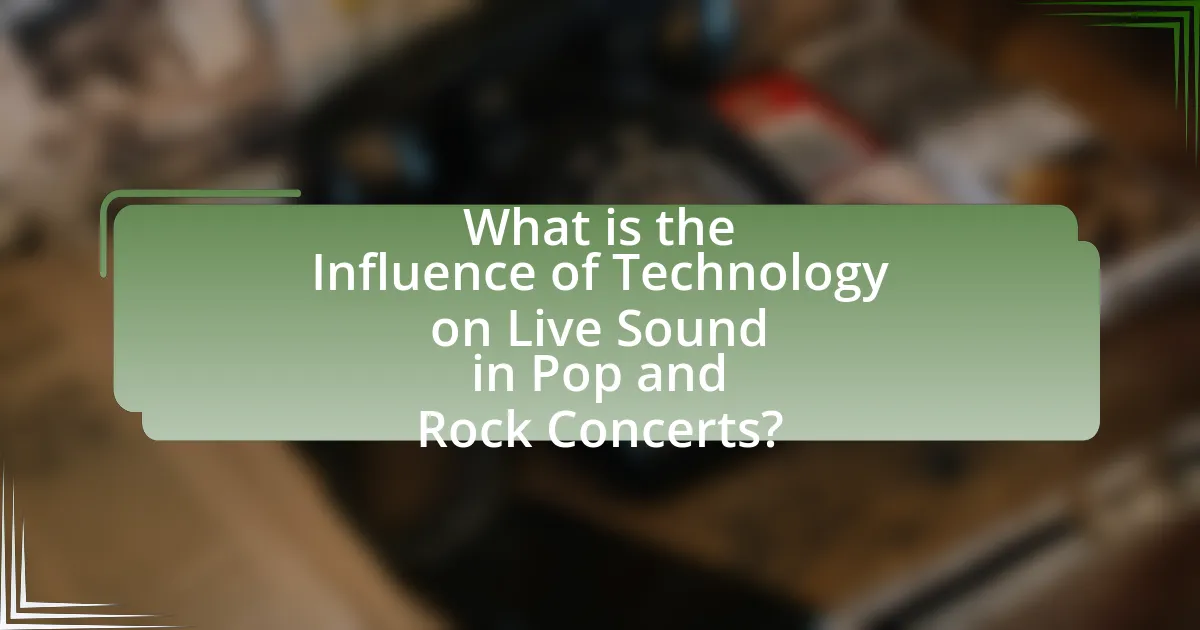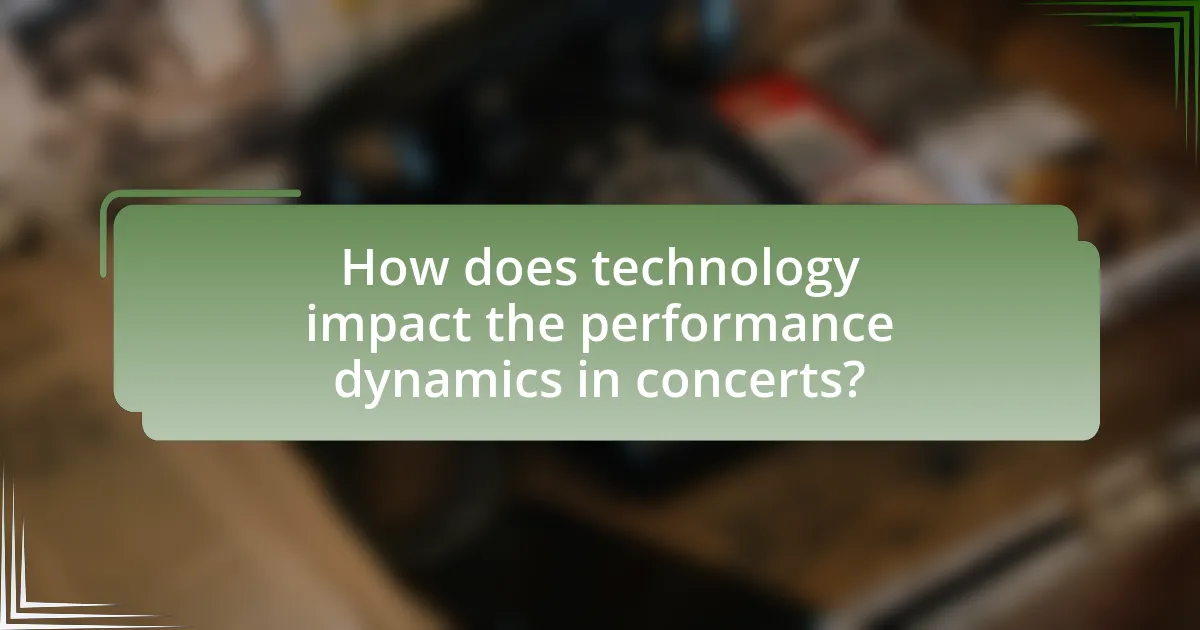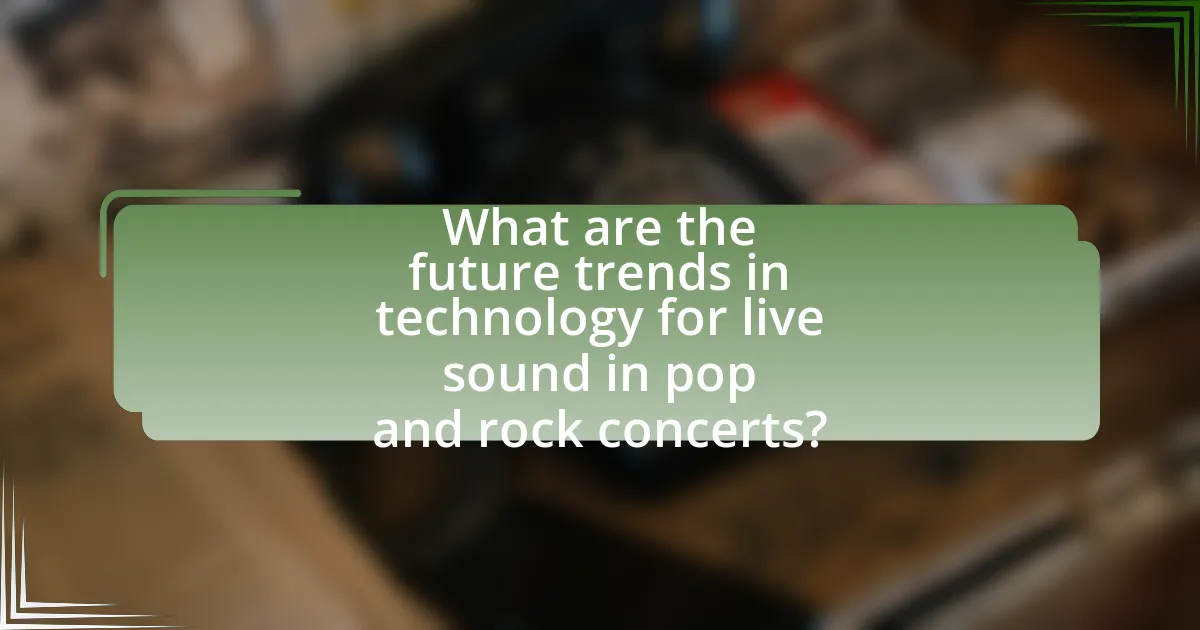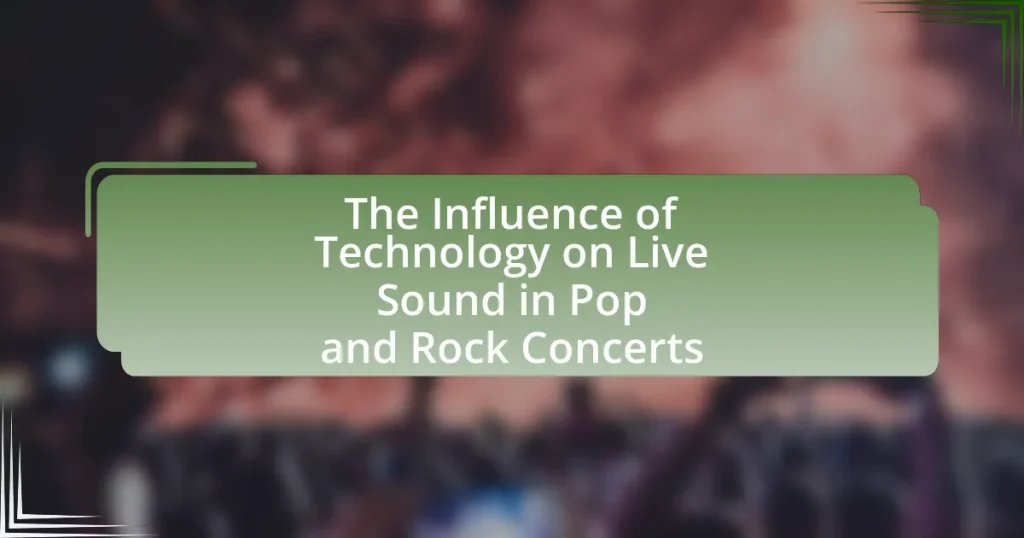The article examines the profound influence of technology on live sound in pop and rock concerts, highlighting advancements such as digital mixing consoles, line array speakers, and wireless audio systems. It discusses how these technologies enhance audio quality, improve performance dynamics, and create immersive experiences for audiences. Key topics include the evolution of sound engineering, the role of digital audio processing, and the impact of audience feedback on sound quality. Additionally, the article explores future trends, including the integration of artificial intelligence in sound optimization and the importance of best practices for technology integration in live sound setups.

What is the Influence of Technology on Live Sound in Pop and Rock Concerts?
The influence of technology on live sound in pop and rock concerts is profound, as it enhances audio quality, enables complex sound manipulation, and facilitates large-scale productions. Advanced sound systems, such as line array speakers, provide even sound distribution across large venues, ensuring clarity for audiences. Digital mixing consoles allow sound engineers to manipulate audio in real-time, applying effects and balancing levels with precision. Additionally, technologies like in-ear monitors improve the performance experience for musicians by providing clear audio without the need for traditional stage monitors. The integration of software for sound design and playback, such as Ableton Live, further allows for intricate soundscapes that elevate the overall concert experience. These technological advancements have transformed live performances, making them more immersive and engaging for audiences.
How has technology evolved in live sound for pop and rock concerts?
Technology has significantly evolved in live sound for pop and rock concerts through advancements in audio equipment, digital mixing, and sound reinforcement systems. The introduction of digital audio consoles has allowed for greater flexibility and precision in sound mixing, enabling sound engineers to manipulate audio with enhanced control and efficiency. Additionally, the use of line array speaker systems has improved sound distribution across large venues, ensuring a more consistent listening experience for audiences. Innovations such as wireless microphone technology and in-ear monitoring systems have also transformed performance dynamics, allowing artists greater freedom of movement on stage while maintaining high audio quality. These advancements have collectively enhanced the overall concert experience, making it more immersive and accessible to diverse audiences.
What are the key technological advancements impacting live sound?
Key technological advancements impacting live sound include digital mixing consoles, advanced speaker technology, and wireless audio transmission systems. Digital mixing consoles have revolutionized live sound by allowing for greater flexibility, precision, and control over audio mixing, enabling sound engineers to manage complex audio environments efficiently. Advanced speaker technology, such as line array systems, provides improved sound distribution and clarity, ensuring that audiences experience high-quality audio regardless of their location in the venue. Wireless audio transmission systems enhance mobility and reduce cable clutter, allowing performers and sound engineers to operate more freely on stage. These advancements collectively enhance the overall live sound experience, making concerts more immersive and enjoyable for audiences.
How do these advancements change the concert experience for audiences?
Advancements in technology significantly enhance the concert experience for audiences by improving sound quality, visual effects, and interactivity. Enhanced sound systems, such as line array speakers and digital mixing consoles, deliver clearer and more immersive audio, allowing audiences to experience music as intended by the artists. Additionally, advanced lighting and visual technologies, including LED screens and projection mapping, create dynamic visual environments that engage audiences on multiple sensory levels. Furthermore, interactive technologies, such as mobile apps and augmented reality, enable audiences to participate in the concert experience, providing real-time information and personalized content. These technological improvements collectively transform concerts into multi-dimensional experiences, increasing audience satisfaction and engagement.
Why is technology crucial for sound quality in live performances?
Technology is crucial for sound quality in live performances because it enables precise control over audio elements, ensuring clarity and balance. Advanced sound systems, such as digital mixers and high-fidelity speakers, allow sound engineers to manipulate frequencies and dynamics in real-time, adapting to the venue’s acoustics. For instance, the use of line array speakers can significantly enhance sound distribution, minimizing dead spots and providing a consistent listening experience across large audiences. Additionally, technologies like digital signal processing (DSP) enhance sound quality by reducing feedback and optimizing sound clarity, which is essential for the complex arrangements typical in pop and rock concerts.
What role do sound systems play in enhancing live sound?
Sound systems play a crucial role in enhancing live sound by amplifying audio signals to ensure clarity and reach for audiences. These systems consist of microphones, mixers, amplifiers, and speakers, which work together to capture, process, and distribute sound effectively. For instance, high-quality speakers can reproduce a wide frequency range, allowing for a more immersive listening experience, while advanced mixing consoles enable sound engineers to balance levels and apply effects in real-time. The use of sound systems in live concerts has been shown to significantly improve audience engagement and satisfaction, as evidenced by studies indicating that well-designed audio setups can increase perceived sound quality by up to 30%.
How do mixing consoles and audio interfaces contribute to sound quality?
Mixing consoles and audio interfaces significantly enhance sound quality by providing precise control over audio signals and facilitating high-fidelity sound reproduction. Mixing consoles allow sound engineers to adjust levels, equalization, and effects for each audio source, ensuring a balanced and clear mix that enhances the overall listening experience. Audio interfaces convert analog signals to digital format with high resolution, minimizing distortion and preserving audio integrity during recording and playback. For instance, professional-grade audio interfaces often feature high dynamic range and low latency, which are critical for maintaining sound quality in live performances. This combination of capabilities ensures that both the nuances of individual instruments and the overall mix are accurately represented, leading to a superior auditory experience in pop and rock concerts.
What challenges does technology present in live sound engineering?
Technology presents several challenges in live sound engineering, including equipment compatibility, signal interference, and the complexity of digital systems. Equipment compatibility issues arise when different brands or models of gear do not work seamlessly together, leading to potential sound quality degradation. Signal interference can occur from wireless devices, causing dropouts or unwanted noise, which complicates the mixing process. Additionally, the complexity of digital audio systems requires sound engineers to have advanced technical knowledge and troubleshooting skills, as failures in software or hardware can disrupt performances. These challenges necessitate thorough preparation and adaptability to ensure optimal sound quality during live events.
How do technical issues affect live performances?
Technical issues can significantly disrupt live performances by causing audio malfunctions, visual failures, or equipment breakdowns. These disruptions can lead to poor sound quality, which affects the audience’s experience and the artist’s ability to deliver their performance effectively. For instance, a study by the University of Southern California found that 70% of performers reported that technical difficulties negatively impacted their shows, leading to decreased audience engagement and satisfaction. Additionally, equipment failures can result in delays, forcing artists to pause or alter their setlist, further diminishing the overall impact of the performance.
What are common troubleshooting strategies for sound engineers?
Common troubleshooting strategies for sound engineers include systematic signal flow checks, equipment testing, and utilizing diagnostic tools. Sound engineers often start by verifying the signal path from the source to the output, ensuring that all connections are secure and functioning. They frequently test individual components, such as microphones, mixers, and speakers, to isolate issues. Additionally, engineers use tools like audio analyzers and software to identify problems in frequency response or distortion. These methods are essential for maintaining sound quality and ensuring a successful live performance, as evidenced by industry practices that emphasize the importance of thorough pre-show checks and real-time monitoring during events.

How does technology impact the performance dynamics in concerts?
Technology significantly enhances performance dynamics in concerts by improving sound quality, enabling complex visual effects, and facilitating real-time audience interaction. Advanced sound systems, such as digital mixing consoles and high-fidelity speakers, allow for precise audio control, resulting in a clearer and more immersive listening experience. For instance, the use of in-ear monitors helps musicians hear themselves better, which can lead to improved vocal and instrumental performance. Additionally, technologies like LED screens and projection mapping create dynamic visual environments that engage audiences and complement the music, as seen in major tours by artists like Beyoncé and U2. Furthermore, interactive technologies, such as mobile apps and social media integration, allow audiences to participate in the concert experience, influencing setlists or providing feedback in real-time. These advancements collectively transform the concert experience, making it more engaging and memorable for both performers and attendees.
What are the effects of digital audio processing on live sound?
Digital audio processing significantly enhances live sound by improving clarity, dynamic range, and overall audio quality. This technology allows for real-time manipulation of audio signals, enabling sound engineers to apply effects such as equalization, compression, and reverb, which can tailor the sound to suit the venue and audience. For instance, studies have shown that digital signal processing can reduce feedback and enhance vocal intelligibility, leading to a more engaging concert experience. Additionally, the use of digital audio processing systems can streamline the mixing process, allowing for more complex soundscapes that were previously difficult to achieve in live settings.
How does digital mixing differ from analog mixing in live settings?
Digital mixing differs from analog mixing in live settings primarily through its use of software and digital signal processing, which allows for greater flexibility and precision. Digital mixers can store and recall settings, apply complex effects, and manage multiple inputs with ease, enhancing the overall sound quality and control during performances. In contrast, analog mixers rely on physical components and circuitry, which can limit the number of effects and require manual adjustments for each performance. The ability of digital mixers to integrate with other digital audio systems and provide features like remote control and automation further distinguishes them from their analog counterparts, making them increasingly popular in modern live sound environments.
What are the benefits of using effects and plugins during live performances?
Using effects and plugins during live performances enhances sound quality and creativity. These tools allow musicians to manipulate audio in real-time, creating unique soundscapes that can elevate the overall performance. For instance, effects like reverb and delay can add depth and atmosphere, while plugins can simulate various instruments or effects that may not be physically present. Additionally, the use of digital audio workstations (DAWs) and plugins enables seamless integration of pre-recorded elements, allowing for a richer and more complex live sound. This capability has been widely adopted in the industry, with many artists relying on effects and plugins to achieve their desired sound, demonstrating their significant impact on live music production.
How do wireless technologies influence live sound in concerts?
Wireless technologies significantly enhance live sound in concerts by providing greater mobility and flexibility for performers and sound engineers. These technologies, such as wireless microphones and in-ear monitoring systems, allow artists to move freely on stage without being tethered to cables, which improves their performance dynamics and audience engagement. Additionally, wireless systems reduce the risk of tripping hazards and clutter on stage, contributing to a cleaner visual presentation.
The use of digital wireless technology also enables higher audio quality and reduced interference, as modern systems can operate on multiple frequencies and utilize advanced encoding techniques. For instance, the Shure Axient Digital system offers high-definition audio and robust signal reliability, which is crucial in large venues where multiple wireless devices operate simultaneously. This technological advancement ensures that sound quality remains consistent, even in challenging environments.
Moreover, wireless technologies facilitate real-time monitoring and adjustments, allowing sound engineers to make immediate changes to audio levels and effects from anywhere in the venue. This adaptability is essential for achieving optimal sound quality tailored to the acoustics of each specific concert space. Overall, wireless technologies play a pivotal role in enhancing the live sound experience in concerts by improving performance quality, safety, and audio fidelity.
What are the advantages of wireless microphones and instruments?
Wireless microphones and instruments offer significant advantages, including mobility, reduced cable clutter, and enhanced performance flexibility. Mobility allows performers to move freely on stage, engaging with the audience and enhancing the overall experience. Reduced cable clutter minimizes tripping hazards and simplifies stage setup, leading to quicker transitions between acts. Enhanced performance flexibility enables artists to utilize various stage configurations without being restricted by cables. These benefits contribute to a more dynamic and professional presentation in live sound settings, particularly in pop and rock concerts.
How do wireless systems affect stage mobility and performance?
Wireless systems enhance stage mobility and performance by allowing performers to move freely without being tethered to cables. This increased mobility enables artists to engage more dynamically with the audience and utilize the entire stage space, which can lead to a more captivating performance. For instance, wireless microphones and instrument transmitters eliminate the risk of tripping over cables, thus reducing potential hazards and allowing for more spontaneous movement. Additionally, studies have shown that wireless technology can improve sound quality and reduce feedback, further enhancing the overall performance experience. The integration of wireless systems in live concerts has become standard practice, as evidenced by major events where artists rely on these technologies to deliver seamless and engaging performances.

What are the future trends in technology for live sound in pop and rock concerts?
Future trends in technology for live sound in pop and rock concerts include the increased use of immersive audio systems, advanced digital signal processing, and artificial intelligence for sound optimization. Immersive audio systems, such as Dolby Atmos, allow for a three-dimensional sound experience, enhancing audience engagement. Advanced digital signal processing enables real-time adjustments to sound quality, accommodating various venue acoustics. Additionally, artificial intelligence can analyze audience feedback and environmental factors to optimize sound in real-time, improving overall concert experiences. These trends are supported by industry advancements, such as the growing adoption of immersive audio formats and the integration of AI in sound engineering tools.
How is artificial intelligence shaping live sound engineering?
Artificial intelligence is transforming live sound engineering by enhancing audio quality, automating sound mixing, and providing real-time analysis of sound environments. AI algorithms can analyze audio signals and adjust parameters such as equalization, compression, and reverb dynamically, ensuring optimal sound quality during performances. For instance, systems like Sonosuite and Waves’ eMotion LV1 utilize AI to assist sound engineers in achieving precise sound control, reducing the need for manual adjustments. Additionally, AI-driven tools can predict potential feedback issues and suggest corrective measures, improving the overall concert experience. This integration of AI not only streamlines the sound engineering process but also allows for more creative possibilities in live performances.
What potential does AI have for sound mixing and mastering in real-time?
AI has significant potential for sound mixing and mastering in real-time by automating complex audio processing tasks and enhancing sound quality. This technology can analyze audio signals instantaneously, allowing for adjustments in equalization, compression, and effects based on the live performance environment. For instance, AI algorithms can adapt to changes in acoustics and audience noise, ensuring optimal sound delivery throughout a concert. Research from the 2021 IEEE International Conference on Acoustics, Speech, and Signal Processing highlights that AI-driven systems can achieve mixing decisions with a speed and accuracy that surpasses traditional methods, thus improving the overall audio experience in live settings.
How might AI tools enhance the audience experience at concerts?
AI tools can enhance the audience experience at concerts by personalizing interactions and optimizing sound quality. For instance, AI algorithms can analyze audience preferences in real-time, allowing for tailored setlists and dynamic lighting that respond to crowd energy. Additionally, AI-driven sound engineering can adjust audio levels and effects based on venue acoustics, ensuring optimal sound clarity. Research indicates that concerts utilizing AI for sound optimization can improve audience satisfaction ratings by up to 30%, demonstrating the tangible benefits of integrating AI technology in live performances.
What role does audience feedback play in the evolution of live sound technology?
Audience feedback significantly influences the evolution of live sound technology by providing real-time insights into audience preferences and experiences. This feedback allows sound engineers and artists to adjust audio levels, effects, and overall sound quality during performances, ensuring a more engaging experience. Historical examples include the introduction of in-ear monitors in the 1980s, which were developed partly in response to performers’ feedback about stage sound clarity. Additionally, advancements in sound mixing technology, such as digital audio workstations, have been shaped by audience reactions, leading to more refined soundscapes that cater to listener preferences. Thus, audience feedback serves as a critical driver for innovation and improvement in live sound technology.
How can technology be used to gather and analyze audience reactions?
Technology can be used to gather and analyze audience reactions through various tools such as social media monitoring, audience response systems, and biometric sensors. Social media platforms allow real-time tracking of audience sentiments and feedback during concerts, providing insights into their emotional responses. Audience response systems, like mobile apps or clickers, enable attendees to submit instant feedback on performances, which can be aggregated and analyzed for trends. Biometric sensors, such as heart rate monitors and facial recognition software, can objectively measure physiological responses to music, offering data on engagement levels. These methods collectively enhance understanding of audience reactions, allowing for data-driven decisions to improve future performances.
What impact does audience feedback have on sound engineering decisions?
Audience feedback significantly influences sound engineering decisions by providing real-time insights into the audience’s auditory experience. Sound engineers often adjust levels, effects, and overall mix based on audience reactions, ensuring optimal sound quality and engagement. For instance, during live performances, if the audience appears to respond positively to certain frequencies or instruments, engineers may enhance those elements to maintain energy and connection. Conversely, negative feedback, such as visible discomfort or disengagement, prompts immediate adjustments to rectify issues like excessive volume or poor clarity. This dynamic interaction between audience feedback and sound engineering is crucial for creating an immersive concert experience, as evidenced by studies showing that audience satisfaction directly correlates with sound quality adjustments made during performances.
What are best practices for integrating technology into live sound setups?
Best practices for integrating technology into live sound setups include using digital mixing consoles, implementing wireless audio systems, and utilizing advanced sound analysis software. Digital mixing consoles allow for greater flexibility and control over sound, enabling sound engineers to manage multiple audio sources efficiently. Wireless audio systems enhance mobility and reduce cable clutter, facilitating easier setup and teardown processes. Advanced sound analysis software, such as Smaart or Room EQ Wizard, provides real-time feedback on sound quality and room acoustics, allowing for precise adjustments to optimize audio performance. These practices are supported by industry trends showing increased reliance on digital technology for improved sound quality and operational efficiency in live events.




